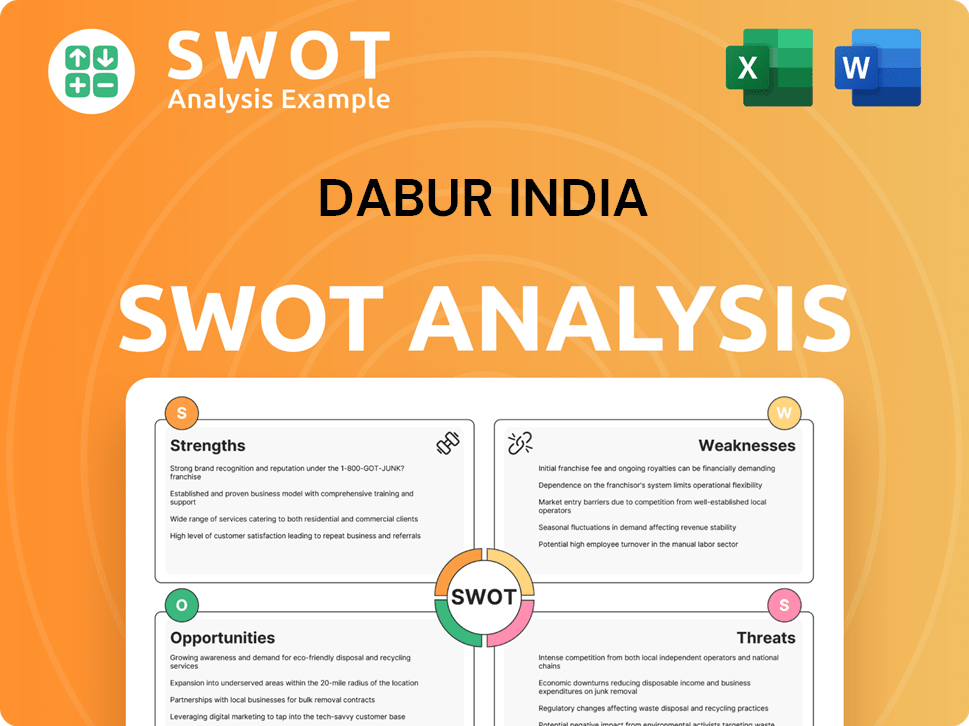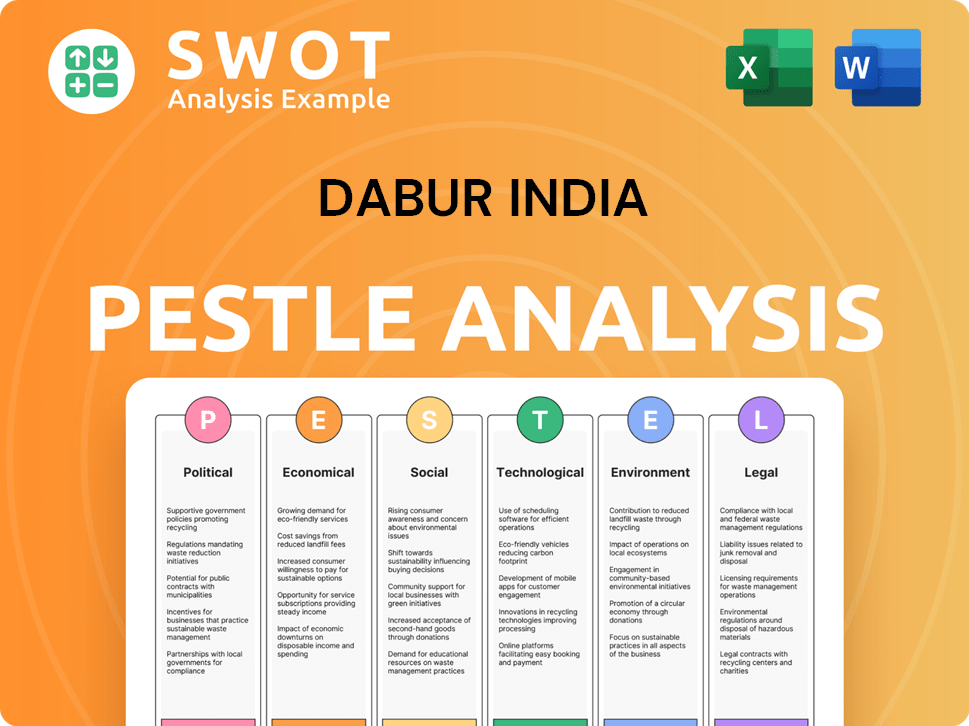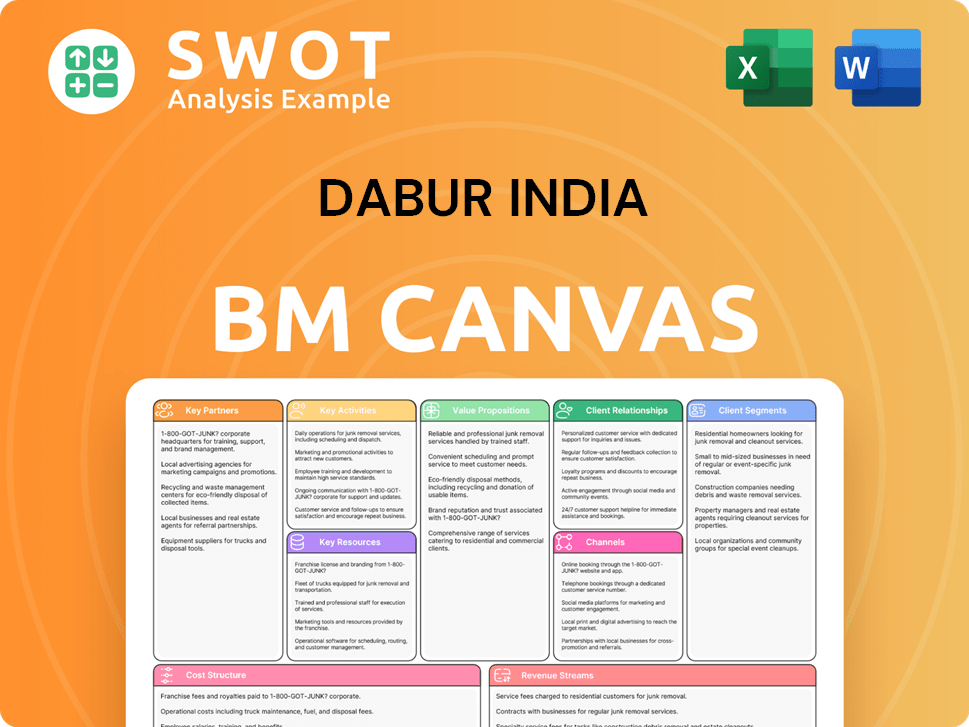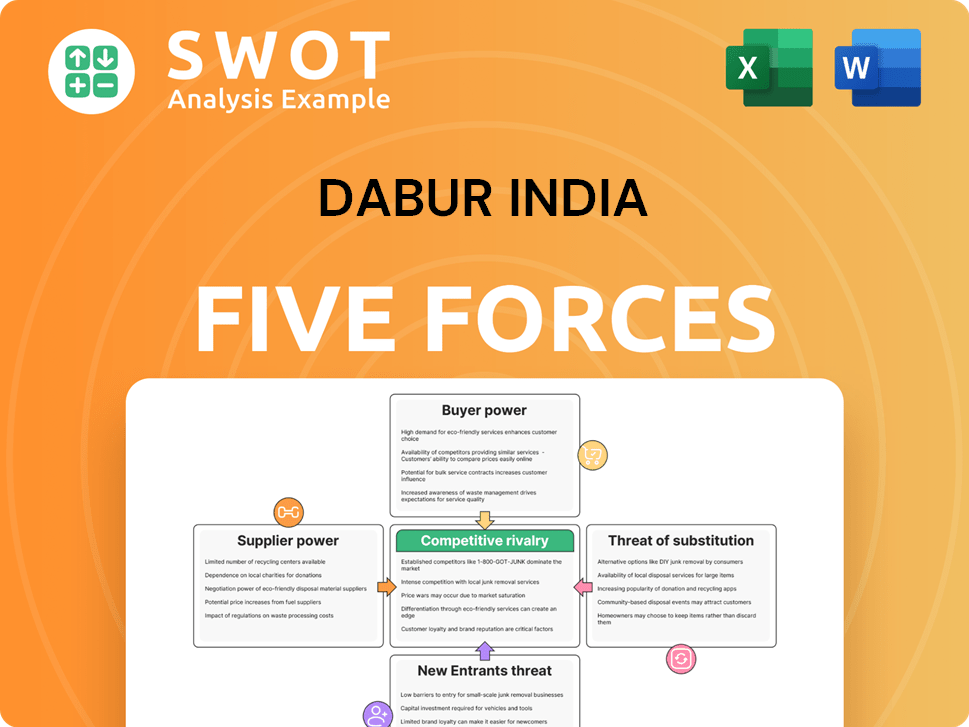Dabur India Bundle
Who Buys Dabur Products? Unveiling Dabur India's Customer Base.
In the dynamic world of Fast-Moving Consumer Goods (FMCG), understanding Dabur India SWOT Analysis is crucial for any company's success. Dabur India, a legacy brand, has successfully navigated changing consumer preferences for over a century. This exploration dives into the heart of Dabur's strategy: its customer demographics and target market, offering a comprehensive look at who buys their products and why.

From Ayurvedic roots to modern FMCG dominance, Dabur India's journey reflects a keen understanding of its evolving Target market. This analysis will dissect the company's market segmentation, examining customer profiles, including age groups, income levels, and geographic locations. We'll explore how Dabur strategically adapts its Dabur products and marketing to resonate with its diverse customer base, ensuring its continued relevance and market share.
Who Are Dabur India’s Main Customers?
Understanding the customer demographics and target market of a company like Dabur India is crucial for grasping its market strategy. Dabur primarily focuses on serving consumers (B2C) through a detailed segmentation approach. This approach considers various factors, including demographics, geographic location, psychographics, and behavioral patterns to reach its target market effectively.
Dabur India's consumer profile is diverse, catering to a wide array of age groups and genders. The company strategically positions its products to appeal to different segments, such as health-conscious individuals and those seeking personal care solutions. The company is also increasingly targeting millennials and centennials, particularly in urban areas, who are willing to invest in natural and effective products.
To understand Dabur India's market, it's essential to analyze its segmentation across different dimensions. This includes the company's market segmentation strategies based on demographics, geography, psychographics, and consumer behavior. This approach enables Dabur to tailor its products and marketing efforts to meet the specific needs and preferences of various customer groups.
Dabur targets a broad age and gender spectrum. Products like Dabur Honey and Chyawanprash cater to health-conscious consumers. Personal care items are designed for diverse age groups and genders. There's a growing focus on millennials and centennials in urban India.
Dabur serves both urban and rural markets. Premium products are offered in urban areas. Affordable, value-for-money options are available in rural markets. The company is expanding its rural footprint to capitalize on demand.
Dabur segments based on consumers' preference for natural and Ayurvedic products. It taps into the growing wellness trend. This includes those who prefer traditional remedies and natural ingredients. The company focuses on brand loyalty and buying patterns.
Dabur analyzes buying patterns and brand loyalty. It targets segments that prefer traditional remedies. The company focuses on those who prefer natural ingredients. This helps tailor marketing strategies.
Dabur India's strategic focus on rural markets is evident in its recent performance. In the fiscal year ending March 31, 2024, rural business growth outpaced urban markets by 400 basis points. Rural sales of FMCG products grew by 7.6% by volume in the quarter ending March 31, 2024, compared to 5.7% in urban markets during the same period. Dabur's expansion into rural areas includes reaching 1.22 lakh villages by the end of FY24, up from 1 lakh villages at the end of FY23, with a goal to reach 1.3 lakh villages by the end of FY25. This expansion, coupled with the introduction of affordable and rural-specific packs, demonstrates a clear shift in targeting to capitalize on rural demand. For more insights into Dabur's growth strategies, you can explore Growth Strategy of Dabur India.
Dabur's target market strategy is multifaceted, addressing diverse customer demographics and preferences. The company's approach includes a focus on both urban and rural markets, with tailored strategies for each.
- Dabur segments its market based on demographics, geography, psychographics, and behavior.
- Rural markets show faster growth, with expansion into more villages.
- The company offers a range of products to cater to various age groups and consumer needs.
- Marketing strategies are adjusted to suit the specific preferences of different segments.
Dabur India SWOT Analysis
- Complete SWOT Breakdown
- Fully Customizable
- Editable in Excel & Word
- Professional Formatting
- Investor-Ready Format

What Do Dabur India’s Customers Want?
Understanding the customer needs and preferences is crucial for the success of any business. For Dabur India, this means focusing on the growing consumer interest in natural and Ayurvedic solutions. This includes a deep dive into what drives purchasing decisions and how to meet those needs effectively.
The target market for Dabur India is increasingly health-conscious, seeking products that are perceived as safe and effective. This customer base is willing to pay more for high-quality products, particularly those with natural ingredients. This is especially true among urban millennials and centennials.
The company tailors its marketing and product features to specific segments. This approach has led to the launch of new and improved herbal healthcare products. Innovation is a core strategy, with new products contributing approximately 5% of revenue in FY22.
Customers of Dabur India are primarily driven by a desire for natural and Ayurvedic solutions. They seek products that offer health and wellness benefits. This reflects a broader trend towards health-conscious living.
Purchasing decisions are influenced by product quality, freshness, flavor, and brand image. Advertisements and packaging also play a significant role. Consumers are increasingly looking for products that promote a clean and hygienic lifestyle.
There's a willingness to pay a premium for effective and safe solutions, particularly among urban millennials and centennials. This indicates a strong customer preference for quality and perceived value. This includes products that are considered natural.
Dabur's products are perceived as offering high value due to their natural ingredients and health benefits. This fosters consumer trust and loyalty. The company's focus on natural ingredients resonates with the target market.
The company addresses common pain points and unmet needs by blending traditional Ayurvedic wisdom with modern science. This approach helps in developing high-quality products. This is a key aspect of the company's strategy.
Feedback and market trends heavily influence product development. Dabur's in-depth study of consumer behavior has led to the launch of new and improved herbal healthcare products. This demonstrates a customer-centric approach.
To meet the needs of its target market, Dabur India employs several strategies, including product innovation and targeted marketing. The company focuses on understanding customer preferences and adapting its offerings accordingly. This approach helps maintain a competitive edge.
- Product Innovation: New products contribute significantly to revenue, with approximately 5% in FY22. This includes launching products like Dabur Organic Honey and Dabur Sundarbans Forest Honey to strengthen its premium honey category.
- Targeted Marketing: Dabur tailors its marketing and product features to specific segments. For example, the Dabur Honey campaign engaged younger populations for weight management.
- Collaboration: Dabur Vatika collaborated with dermatologists to co-create specialized hair oils. This approach ensures products meet specific consumer needs.
- Consumer Insights: The company conducts in-depth studies of consumer behavior. This leads to the launch of new and improved herbal healthcare products.
- Brand Positioning: Dabur's brand positioning emphasizes natural ingredients and health benefits. This resonates with health-conscious consumers.
For a deeper understanding of the competitive landscape, it's beneficial to explore the Competitors Landscape of Dabur India.
Dabur India PESTLE Analysis
- Covers All 6 PESTLE Categories
- No Research Needed – Save Hours of Work
- Built by Experts, Trusted by Consultants
- Instant Download, Ready to Use
- 100% Editable, Fully Customizable

Where does Dabur India operate?
The geographical market presence of the company is extensive, with a strong focus on India alongside a global footprint. It operates in over 120 countries, including regions like the Middle East, SAARC nations, Africa, the US, Europe, and Russia. This wide reach allows the company to cater to diverse consumer profiles and preferences across different regions.
Within India, the company targets both urban and rural areas, demonstrating a comprehensive market segmentation strategy. This dual approach allows it to capture a broad customer base, leveraging its brand recognition and market share across various product categories. The company's ability to adapt its offerings to suit both urban and rural markets is a key factor in its sustained growth.
The company's strategy involves tailoring its products and marketing efforts to suit the specific needs of each region. For instance, the company has been expanding its rural footprint, adding 22,000 villages to reach 122,000 villages in FY24, with plans to expand to 1.3 lakh villages by the end of FY 2024-25. This is part of a broader strategy to increase its presence and cater to the growing demand in these areas. For a deeper dive into the company's marketing approach, explore the Marketing Strategy of Dabur India.
The company is actively increasing its presence in rural areas. As of FY24, it reached 122,000 villages, with plans to expand to 1.3 lakh villages by the end of FY25. This expansion is driven by the growing consumer base and increasing demand in rural markets.
In urban markets, the company focuses on premiumization. This includes offering larger pack sizes and introducing new brands in premium categories, especially through e-commerce platforms. These strategies are designed to attract millennials and centennials.
The company has gained market share across a significant portion of its portfolio. In FY24, it gained market share across 90% of its portfolio. This growth is a testament to its effective strategies and strong brand presence.
Rural markets have shown stronger growth compared to urban markets. In the quarter ending March 31, 2024, rural markets grew by 7.6% by volume, while urban markets grew by 5.7%. This highlights the increasing importance of rural markets.
The company localizes its offerings to suit different markets. This includes introducing affordable and rural-specific packs to cater to the hinterlands and expanding its product basket. This approach helps to meet the specific needs of diverse customer demographics.
The company is revamping its go-to-market strategy. This includes focusing on emerging channels like e-commerce, quick commerce, and modern trade for more effective expansion across urban and rural India. This ensures that the company reaches its target market efficiently.
Dabur India Business Model Canvas
- Complete 9-Block Business Model Canvas
- Effortlessly Communicate Your Business Strategy
- Investor-Ready BMC Format
- 100% Editable and Customizable
- Clear and Structured Layout

How Does Dabur India Win & Keep Customers?
The company, employs a comprehensive approach to both acquire and retain customers, utilizing a blend of traditional and digital marketing strategies. This 360-degree approach includes significant investments in advertising across various platforms, such as television, print media, and digital channels. These campaigns often highlight the natural benefits of their products, frequently incorporating celebrity endorsements to enhance credibility and appeal. This strategy is crucial for reaching a diverse customer base, from those who are familiar with traditional advertising to those who are more engaged with digital content.
The company has strategically increased its spending on digital marketing, with a considerable portion allocated to influencer marketing. This shift signifies an effort to effectively reach tech-savvy and health-conscious consumers, particularly millennials and Gen Z. By focusing on digital platforms, the company aims to enhance its brand visibility and engagement, ultimately driving sales and strengthening its market position. Understanding the customer demographics and adapting marketing efforts accordingly is key to sustained growth.
The company's digital marketing strategy includes leveraging social media platforms such as Instagram, YouTube, and Facebook to create engaging content and execute targeted online campaigns. Additionally, the company has embraced e-commerce, launching its own direct-to-consumer (D2C) portal, Dabur Shop, to serve as a comprehensive online destination for its products and expand online sales. Digital-first brands, launched online, grossed over ₹100 crore in turnover in FY24. The company also uses data analytics to understand consumer behavior and preferences, enabling personalized experiences and streamlined campaigns.
The company uses social media platforms like Instagram, YouTube, and Facebook for engaging content and online campaigns. It also has a D2C portal, Dabur Shop, to expand online sales and reach consumers directly. Digital-first brands generated over ₹100 crore in turnover in FY24, showing the success of its online efforts.
The company uses data analytics to gain insights into consumer behavior and preferences. This data helps in creating personalized experiences and streamlining marketing campaigns. This data-driven approach ensures that marketing efforts are targeted and effective.
The company focuses on continuous innovation and product diversification to meet evolving consumer needs. New products and formats are introduced under its power brands to extend their lifecycle and expand the total addressable market. This strategy helps in maintaining relevance and attracting a wider customer base.
Loyalty is built on the trust associated with the brand, stemming from its Ayurvedic heritage and commitment to quality. This strong brand reputation helps retain customers and fosters long-term relationships. This commitment to quality and tradition is a key factor in customer retention.
To retain customers, the company focuses on continuous innovation and product diversification, ensuring its offerings remain relevant to evolving consumer needs. The company has been introducing new products and formats under its power brands, aiming to extend their lifecycle and expand the total addressable market. Loyalty is built on the trust associated with the brand, stemming from its Ayurvedic heritage and commitment to quality. The company aims to achieve double-digit annual growth in both revenue and profit by FY28, with strategies including investing heavily in core brands, expanding in premium categories, and aggressively pursuing acquisitions. The company's robust distribution network, covering over 7.9 million retail outlets and reaching 1.22 lakh villages, ensures widespread availability and contributes to market leadership. Understanding the Brief History of Dabur India helps to understand the company's commitment to its customers.
Dabur India Porter's Five Forces Analysis
- Covers All 5 Competitive Forces in Detail
- Structured for Consultants, Students, and Founders
- 100% Editable in Microsoft Word & Excel
- Instant Digital Download – Use Immediately
- Compatible with Mac & PC – Fully Unlocked

Related Blogs
- What are Mission Vision & Core Values of Dabur India Company?
- What is Competitive Landscape of Dabur India Company?
- What is Growth Strategy and Future Prospects of Dabur India Company?
- How Does Dabur India Company Work?
- What is Sales and Marketing Strategy of Dabur India Company?
- What is Brief History of Dabur India Company?
- Who Owns Dabur India Company?
Disclaimer
All information, articles, and product details provided on this website are for general informational and educational purposes only. We do not claim any ownership over, nor do we intend to infringe upon, any trademarks, copyrights, logos, brand names, or other intellectual property mentioned or depicted on this site. Such intellectual property remains the property of its respective owners, and any references here are made solely for identification or informational purposes, without implying any affiliation, endorsement, or partnership.
We make no representations or warranties, express or implied, regarding the accuracy, completeness, or suitability of any content or products presented. Nothing on this website should be construed as legal, tax, investment, financial, medical, or other professional advice. In addition, no part of this site—including articles or product references—constitutes a solicitation, recommendation, endorsement, advertisement, or offer to buy or sell any securities, franchises, or other financial instruments, particularly in jurisdictions where such activity would be unlawful.
All content is of a general nature and may not address the specific circumstances of any individual or entity. It is not a substitute for professional advice or services. Any actions you take based on the information provided here are strictly at your own risk. You accept full responsibility for any decisions or outcomes arising from your use of this website and agree to release us from any liability in connection with your use of, or reliance upon, the content or products found herein.